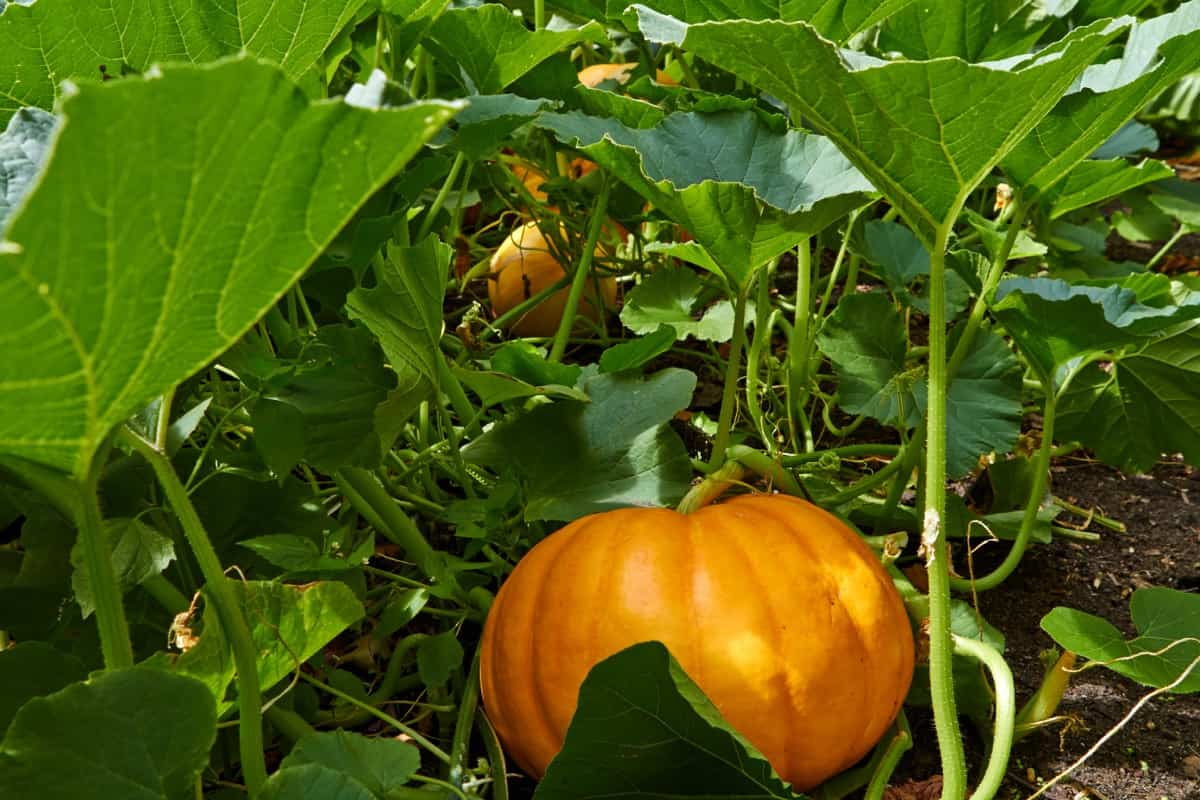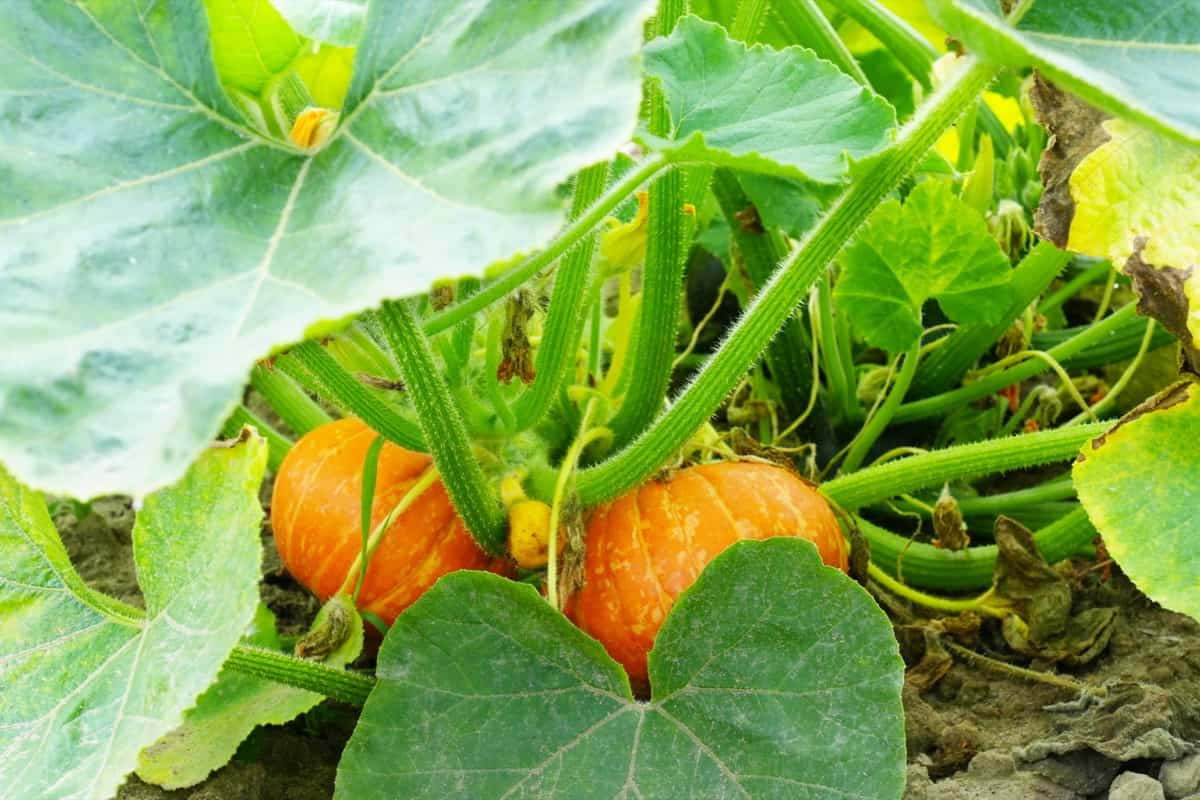Pumpkin plants can face various problems that can hinder their growth and productivity. These issues can frustrate gardeners, from diseases caused by fungi or viruses to pests that feed on the leaves and fruits. Remember that each situation may require different approaches based on climate conditions and local pest populations.

8 Common Problems with Pumpkin Plants
Preventing Pumpkin Vine Borers: Effective Control Methods
One of the most common problems that Pumpkin plants face is the infestation of vine borers. These pesky insects can cause extensive damage to the vines, ultimately reducing harvest. It’s important to regularly inspect your Pumpkin plants for any signs of vine borer eggs or larvae. Look out for small holes in the stems and frass near the base of the plant. If you spot these indicators, immediately remove and destroy them to prevent further infestation.
Another preventive measure is using physical barriers such as row covers or aluminum foil around the base of each plant stem. This creates a barrier that prevents adult vine borers from laying their eggs on the plants. Additionally, practicing crop rotation can be beneficial in controlling vine borer populations. Planting Pumpkins in different areas each year reduces the chances of these pests finding suitable host plants.
Dealing With Powdery Mildew on Pumpkin Leaves
One of the most common problems when growing Pumpkins is powdery mildew on the leaves. To avoid powdery mildew from taking hold in the first place, make sure your Pumpkin plants have adequate spacing and good air circulation. Avoid overhead watering as much as possible since damp conditions promote fungal growth.
If you observe any symptoms of powdery mildew on your Pumpkin leaves, act quickly to minimize its spread. One natural remedy you can try is a mixture of baking soda and water. Mix one tablespoon of baking soda with a gallon of water and spray it onto the affected leaves. Another option is using neem oil or horticultural oil. These oils work by suffocating the spores and preventing further infection. Be sure to follow the instructions carefully when applying any fungicide.
Additionally, removing infected leaves can help slow down the progression of powdery mildew. Just be mindful not to remove too many healthy leaves, which provide vital nutrients for your Pumpkin plants. Remember that prevention is always better than cure when dealing with powdery mildew on Pumpkin leaves.
Pumpkin Pests
| Pests | Symptoms | Prevention |
| Squash bug | These flat-bodied insects suck sap from Pumpkin leaves, causing wilting and yellowing. | To combat them naturally, handpick and destroy their eggs early in the season before they hatch. You can also lay down a barrier of diatomaceous earth around your Pumpkin patch to deter them. |
| Aphids | These tiny insects feast on tender new growth and leave a sticky honeydew residue. | To get rid of aphids naturally, blast them off with a strong stream of water or introduce beneficial insects like ladybugs or lacewings that feed on aphids. |
| Slugs and snails | Feasting on young Pumpkin seedlings, leaving behind unsightly holes in their wake. | To deter these slimy creatures naturally, sprinkle crushed eggshells or coffee grounds around your plants as a rough barrier they won’t want to crawl over. |
Identifying and Treating Pumpkin Fruit Rot
Pumpkin fruit rot can be a frustrating problem for gardeners, as it can quickly ruin the fruits you’ve worked so hard to grow. Several different types of fruit rot can affect Pumpkins, including blossom-end rot and black rot. One common cause of Pumpkin fruit rot is poor air circulation around the plants. This causes moisture buildup on the fruits, creating an ideal environment for fungal growth. To prevent this, space your Pumpkin plants adequately and prune back any excessive foliage.
In case you missed it: How to Increase Female Flowers in Pumpkin: Explained in 10 Simple Steps

Another common culprit of Pumpkin fruit rot is overwatering. Pumpkins prefer moist soil but not soggy conditions. Fungal diseases like powdery mildew or gray mold can contribute to Pumpkin fruit rot. These diseases often manifest as fuzzy white or gray patches on the surface of the fruits. To treat these fungal infections, remove any affected fruits immediately and dispose of them in a sealed bag.
Nutrient deficiencies can sometimes make weakened Pumpkins more susceptible to rotting. Regularly fertilize your plants with a balanced fertilizer for vegetables like Pumpkins. Practicing good sanitation in your garden is essential for preventing Pumpkin fruit rot. Remove any fallen leaves or decaying organic matter from around your plants regularly.
Managing Nutrient Deficiencies in Pumpkin Plants
Nutrient deficiencies can be a common problem for Pumpkin plants, causing stunted growth, yellowing leaves, and poor fruit development. There are ways to manage these deficiencies and ensure your Pumpkins get the nutrients they need to thrive. It’s important to identify which nutrient is lacking in your soil. Common nutrient deficiencies in Pumpkins include nitrogen, phosphorus, potassium, calcium, and magnesium. Once you’ve identified the deficient nutrient(s), there are several methods you can employ to address the issue.
One option is to amend the soil with organic matter. These materials help improve overall soil fertility and provide a slow release of nutrients over time. Another approach is foliar feeding – applying liquid fertilizer directly onto the leaves of your Pumpkin plants. This method allows for the quick absorption of nutrients by the foliage and can help alleviate deficiencies more rapidly. Additionally, balanced fertilizers formulated for Pumpkins can boost essential nutrients throughout their growing season.
Preventing Pumpkin Plant Wilting and Drooping Leaves
Pumpkin plants are known for their vibrant leaves and lush vines, but sometimes you may notice that your Pumpkin plant’s leaves start to wilt and droop. This can be a frustrating problem for any gardener, but there are steps you can take to prevent it. One common cause of wilting and drooping leaves in Pumpkin plants is underwatering. When the soil becomes too dry, the roots cannot absorb enough water, causing the leaves to lose turgidity. To prevent this issue, water your Pumpkin plants consistently and deeply.
Another potential cause of wilting and drooping leaves is overwatering. When the soil becomes oversaturated with water, it can lead to root rot and poor oxygen circulation. To avoid this problem, ensure your Pumpkin plants are planted in well-draining soil. Inadequate nutrient uptake can also contribute to wilting and drooping leaves in Pumpkin plants. Ensure your Pumpkins receive nutrients like nitrogen, phosphorus, potassium, calcium, magnesium, and iron through regular fertilization or organic amendments.
Identifying and Treating Pumpkin Leaf Spot Diseases
Identifying and treating Pumpkin leaf spot diseases is essential for maintaining healthy plants and ensuring a successful harvest. To properly identify the specific leaf spot disease affecting your Pumpkin plants, it’s important to examine the characteristics of the spots closely. Once you’ve identified the leaf spot disease, treatment options can vary depending on the pathogen involved. Fungicides containing copper-based compounds are often effective in controlling fungal infections.
However, following application instructions carefully and avoiding spraying during excessive heat or humidity periods is important. In addition to fungicide treatments, cultural practices can help prevent and manage leaf spot diseases. Regularly removing infected plant debris and practicing crop rotation can reduce disease pressure. Ensuring proper air circulation around plants by spacing them adequately also helps prevent moisture buildup that promotes fungal growth.
Managing Excessive Vine Growth in Pumpkin Plants
Excessive vine growth is a common problem faced by many Pumpkin growers. While it may seem beneficial at first, as the vines spread and take up more space, they can become unruly and hinder the overall health of your plants. One effective method is pruning. By selectively removing some of the secondary vines that grow off the main stem, you can control the growth and redirect energy toward fruit production. Be sure to use clean pruning tools to avoid spreading diseases.
Another approach is training the vines. This involves gently guiding them along a trellis or support structure to keep them contained and prevent sprawling. Not only does this help with managing excessive growth, but it also improves air circulation around the plants, reducing the risk of disease. Regularly monitoring for signs of overgrowth is crucial in preventing any further complications. Keep an eye out for tangled or overlapping vines, as these are indicators that intervention may be needed.
In case you missed it: How to Grow Pumpkin from Seed in Greenhouse: A Step-By-Step Guide for Seed to Harvest

Conclusion
Growing Pumpkins can be a rewarding and enjoyable experience. However, like plants, they are susceptible to various problems hindering their growth and productivity. Remember to regularly inspect your plants for any disease or pest infestation signs. Prompt action is crucial in addressing these issues before they escalate and cause irreversible damage. Additionally, adopting preventive measures such as proper watering techniques, providing adequate nutrition, and maintaining good garden hygiene will contribute greatly to the overall health of your Pumpkin plants.
- Ultimate Guide to Ossabaw Island Hog: Breeding, Raising, Diet, and Care
- Ultimate Guide to Juliana Pig: Raising Facts, Size, Diet, Care, and Lifespan
- Raising Lleyn Sheep: Disadvantages, Price, Uses, Characteristics, and Care
- Ultimate Guide to Meishan Pig: Breed Facts, Breeding, Raising, and Care
- Ultimate Guide to Teacup Pigs: Raising, Diet, Lifespan, Cost, and Care
- Guide to Raising Poll Dorset Sheep: Facts, Profile, Characteristics, Uses, and Care
- Ultimate Guide to Bighorn Sheep: Characteristics, Diet, Lifespan, Breeding, and Lifecycle
- Ultimate Guide to Raising Katahdin Sheep: Farming Facts, Breed Profile, Uses, and Care
- Ultimate Guide to Raising Oreo Cows: Belted Galloways Farming Facts, Profile, Uses, and Care